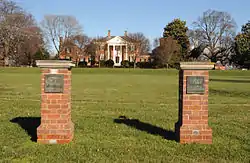Wye River (plantation)
The Wye River plantation, or Wye Hall was the Eastern Shore of Maryland home of William Paca, a signer of the Declaration of Independence,[2] constructed in 1765, and extensively renovated in 1790 by John Paca, with Joseph Clark as architect, at a cost of $20,000.[3][4] He gained ownership of the property in Queen Anne's County, Maryland, through his wife, Mary Chew.[5] John Beale Bordley and Margaret Chew inherited the other half of Wye Island.
Wye Hall | |
 | |
  | |
| Location | 505 Wye Hall Dr., near Queenstown, Maryland |
|---|---|
| Coordinates | 38°53′20″N 76°7′7″W |
| Area | 212 acres (86 ha) |
| Built | 1936 |
| Architect | Tilden, Register and Pepper |
| Architectural style | Georgian Revival |
| NRHP reference No. | 15000759[1] |
| Added to NRHP | November 2, 2015 |
William Paca is buried at the family cemetery there. The Paca residence burned down in 1879.[6][7] The University of Maryland, College Park conducted archeological work there.[8]
Wye Hall was built in the 1930s on the site of the estate of William Paca. In 1999, it was purchased by Leland C. Brendsel.[9] A mechanics lien was filed for work done there.[6]
References
- "National Register Information System". National Register of Historic Places. National Park Service. July 9, 2010.
- John Thomas Scharf (1879). History of Maryland from the Earliest Period to the Present Day. J. B. Piet. p. 225.
- James D. Kornwolf, Georgiana Wallis Kornwolf (2002). Architecture and town planning in colonial North America. JHU Press. p. 1464. ISBN 978-0-8018-5986-1.CS1 maint: uses authors parameter (link)
- "Biography of Mary Chew Paca". Colonial Hall. 2005-01-05. Retrieved 2016-08-01.
- Grzincic, Barbara (2005). "Court of Special Appeals awards Wye Hall contractor right to". The Daily Record.
- Hester D. Richardson (1995). Side-Lights on Maryland History. Clearfield Company. ISBN 978-0-8063-0296-6.
- Shin, Annys (2005-09-30). "Ex-Freddie Mac Chief Loses Lease". The Washington Post. Retrieved 2010-04-16.

